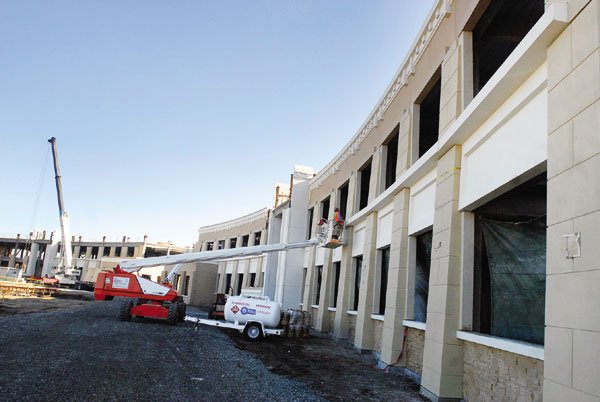When a summer shower of lightning bolts rained down across the
state, the mountains surrounding Gilroy were struck by two fires
that caused days of mayhem but little property damage and no
injuries.
1. Hummingbird and Whitehurst fires
When a summer shower of lightning bolts rained down across the state, the mountains surrounding Gilroy were struck by two fires that caused days of mayhem but little property damage and no injuries.
More than 1,000 acres burned in the Hummingbird and Whitehurst fires that sparked up during tinderbox conditions in June, sending residents and propertyholders – including a number of vineyard owners – scrambling to find shelter, protect their homes and save their livestock. However, thanks to a quick and thorough response by firefighters – who were also aided by kind winds – not a single structure was lost and few experienced anything more than some smoke damage. Within three days, most residents had returned to their homes and resumed normal lives.
An unusually dry spring and whipping winds ripened fire conditions early on and made this one of the state’s busiest fire seasons as blazes burned from May into November, leaving a gray haze over large chunks of the state and an acrid smell burning the back of Californians’ throats for a good portion of the summer. Among other major blazes was the Summit Fire, which ushered in the fire season in late May and burned 4,200 acres in the Santa Cruz Mountains. The fire razed a dozen homes and brought armies of firefighters and Governor Arnold Schwarzenegger to Gilroy.
2. Housing and market meltdown
When fires weren’t threatening residents’ homes, the housing crisis was.
Perhaps more than anything else this year, residents heard about the sub-prime loan debacle. The resulting standstill in development – along with a deflating stock market and shrinking tax receipts – effectively strangled City Hall with tens of million in debt and forced layoffs. With no developer fee money coming in, the city also had to tap its general fund reserve to insure $32 million worth of infrastructure and public facility projects, including a $6 million portion of the new high school. The rainy day fund held $26 million a year ago, but staff expects the reserve to drop to less than $8 million by June 2009 and down to about negative $11 million a year later.
At the same time the city’s savings have dwindled, Gilroy’s housing inventory has risen.
About one in 15 houses, or about 800 homes, languish in some stage of foreclosure. Dozens also have abandoned pools, which can become breeding grounds for mosquitoes and watering holes for crows and other birds susceptible to the West Nile virus — so much so that a vector control specialist with the county spent most of his summer days this year surveying local sites and spraying any larvae he found with a lethal substance.
3. Layoffs and cutbacks
Some four dozen city employees received pink slips as early Christmas presents, the result of a difficult and at times acrimonious tightening of the city belt.
By laying off 48 full-time employees – mostly engineers, inspectors, office assistants, planners and other non-safety personnel – and 12 part-time employees, the city’s finance officials expect this fiscal year’s deficit will total $2.3 million, down from about $6 million two months ago. They predict Gilroy will end up about $900,000 in the black next year largely thanks to personnel cuts, but that’s assuming Gilroy’s share of the housing crisis tapers off and the state does not withhold millions more to hew its own debt.
In the meantime, Gilroy will lay off six firefighters and cut back operations at Sunrise Fire Station by rendering it an ambulance-only facility. Volunteers will try to save the museum from closing. City sports teams will go without uniforms or officials and colleagues who did not receive layoff notices may find themsevles packing their desks by Jan. 31 if someone who was laid off higher up decides to “bump” that lower-ranking employee into unemployment – a system based on seniority that has some at City Hall still biting their nails.
4. Gang violence
Three murders and a rash of stabbings and shootings made 2008 one of the most violent years in recent record for Gilroy.
Gang violence claimed the lives of two Gilroy teens and a third man was stabbed to death outside one of Gilroy’s most notorious bars, Rio Nilo.
With more than 750 gang members and their associates living in Gilroy, and more than 1,300 people on probation or parole – about 2.6 percent of the city’s population – police, under new Chief of Police Denise Turner, have renewed their efforts against the inordinately high number of criminals living in Gilroy.
Meanwhile, the community came together for multiple rallies, peace marches and vigils following the November gang-related shooting death of an 18-year-old just blocks from the Gilroy Police Department – marking the second homicide in a month’s time – and sparking the beginnings of what police and the community feared could turn into an all out gang war.
5. November bonds and elections
Despite the downward spiral of home values and the jump in unemployment, foreclosures and economic unease, the people of Gilroy passed $187 million in local bonds this November.
Though some voters were surprised to hear their ‘no’ votes were far outweighed by the outpouring of support for a $150 million school facilities bond and a $37 million library bond, campaign managers said it was no easy task convincing the voters to take on millions of dollars in debt.
The school bond will fund the continued construction of Christopher High School, Gilroy’s second high comprehensive high school and ensure an on-time opening in August 2009. The library bond will fund the construction of a new library, 42 years after voters passed the first bond to build the city’s now cramped library.
The new tax will tack about $380 extra onto the average homeowner’s property tax bill.
6. Improved school test scores
After only one year with a new superintendent at the helm, the Gilroy Unified School District made significant strides in academic achievement.
The district boosted its roster of schools meeting state growth targets to eight, up from the previous year’s one. In addition, the district underdog, Eliot Elementary School, shined brighter than ever. Led by a new principal, James Dent, the school added 83 points to its state test score – the largest growth in the county – and highlighted the district’s new can-do mentality.
School officials attributed the district’s overall success to the wealth of new administrators appointed to head several schools and district departments and to increased standards in the classroom, but they acknowledged that there is work to be done: tackling the stark achievement gap that still pervades schools throughout the district and across the state.
7. Gilroy Gardens
The city has become the proud new owner of the Gilroy Gardens amusement and horticultural park, but has been paying the price of harsh criticism as a result.
City employees have blamed the $13.2 million purchase of the park and surrounding lands for recent layoffs because the city borrowed the money from its impact fee funds at the same time developers stopped paying into them. The general fund reserve had to insure the difference, and salaries come from the general fund, but the council has said many more factors – including falling property values and tax receipts, increasing benefits costs for employees, a recent pattern of deficit spending and an over-reliance on a retail-based economy – have all contributed to the layoffs.
But employees have said that is hard to swallow as developers knock on the Gardens’ door.
In October, the Dispatch learned of a group of Asian investors who offered to buy Gilroy Gardens and the 536 acres of mostly untouched land it sits on for about $35 million. They withdrew their offer later that month, but other developers have envisioned adding a world-class theme park to the hulticultural haven there now. Florida-based Parc Management has also expressed interest in adding a water park for children.
8. Sidewalks
With far more contention and history than the Gilroy Gardens debate, fixing sidewalks continued to divide the council in 2008.
After one school teacher scraped and bloodied her face on her way to the Garlic Festival this year and the council created a new repair program, spending nearly $900,000 fixing a problem that will cost millions more to solve. The current solution is dubbed the 80-20 program, whereby residents evenly split the cost of sidewalk repair with the city and then pay nothing for new curb and gutters, asphalt and tree removal – which ends up with residents footing about 20 percent of the total cost. So far this year, 103 properties have taken part at about $5,100 per repair, and the extra funding should cover about 68 of the 89 property owners on the repair waiting list.
The split body also recently decided to issue IOUs to property owners to redeem next fiscal year if the cash runs out. Amid layoffs and exigent circumstances, complaints about spending money on sidewalks have arisen. This has caused some council members to treat sidewalk repairs with different attitudes. Others, however, have emphasized that the sidewalk repairs were part of their campaign promises and have stuck to fully funding the program.
9. Christopher High School
With a new principal, a roster of teachers and its physical structure underway, Gilroy’s second comprehensive high school is inching closer to completion. Most importantly, Gilroy voters passed a $150 million bond to ensure just that.
The first phase of what has turned into a $180 million high school is scheduled to open its doors to 600 ninth and 10th graders come fall. A months-long boundary battle divided the town and now that the line of demarcation is final, school administrators are determined to foster nothing more than a friendly rivalry between the CHS Cougars and the Gilroy High School Mustangs. But with a transfer policy in progress, some students will have to choose between attending a state of the art high school with freshman clubs and sports teams or the more established GHS, with an award winning choir program and champion sports teams.
10. City hires
Chief Denise Turner and Cit Administrator Tom Haglund have both had to lead their respective departments through financial free-falls and a troubling spate of gang-related violence that has recently taken brief respite. Sworn officers have so far avoided layoffs, but they have also upped their presence on the street and started knocking on more probationers doors. At times, though, friends and families close to the victims of gang-related violence say the police can be too intrusive.
While Haglund does not have to wear a bullet proof vest, he has taken a lot of heat from the economy, a council that has asked him to cut and dozens of colleagues he has decided to lay off. Despite all the doom and gloom, Haglund and his staff predict a rosier economy, and the administrator who has cut nearly $8 million dollars in spending since joining the city in May.














